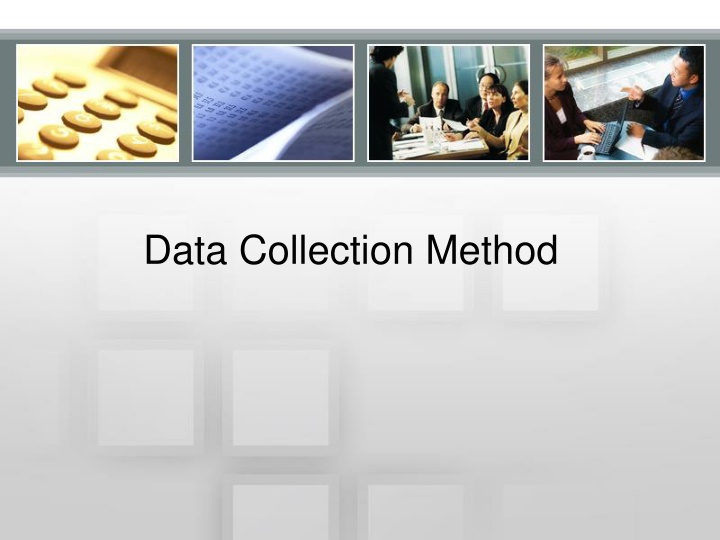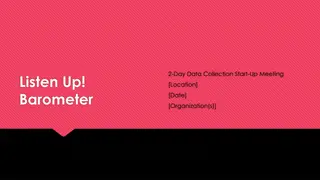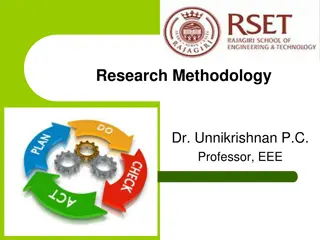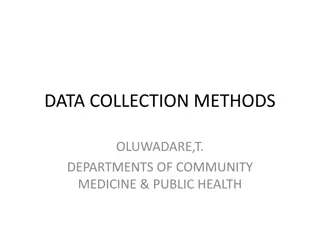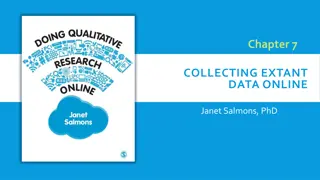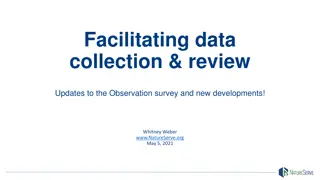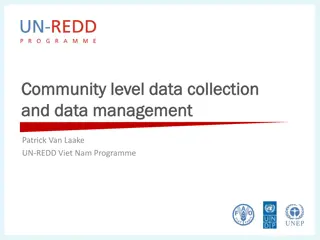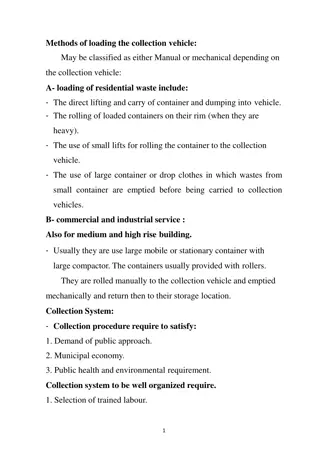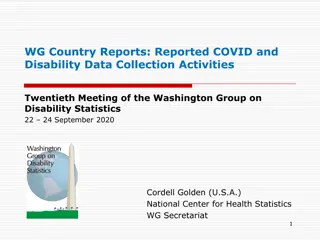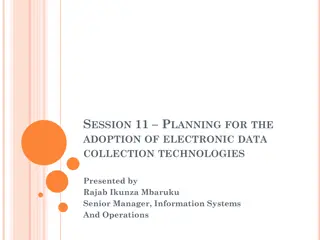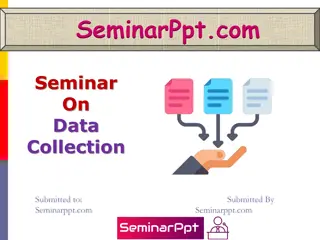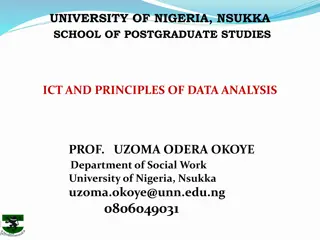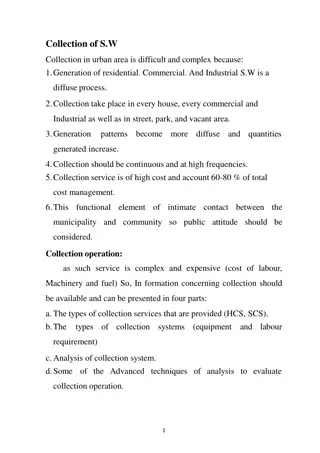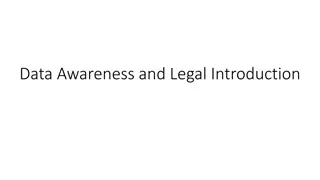Effective Data Collection Methods
Primary and secondary sources of data, including focus groups, panels, and observation techniques. Learn about the advantages and drawbacks of each method, such as cost savings and potential limitations. Discover various data collection methods like surveys, questionnaires, interviews, and unobtrusive techniques. Delve into the nuances of observation, including nonparticipant and participant observations, structured and unstructured approaches, and evaluating behavioral observations for strengths and weaknesses.
Download Presentation

Please find below an Image/Link to download the presentation.
The content on the website is provided AS IS for your information and personal use only. It may not be sold, licensed, or shared on other websites without obtaining consent from the author.If you encounter any issues during the download, it is possible that the publisher has removed the file from their server.
You are allowed to download the files provided on this website for personal or commercial use, subject to the condition that they are used lawfully. All files are the property of their respective owners.
The content on the website is provided AS IS for your information and personal use only. It may not be sold, licensed, or shared on other websites without obtaining consent from the author.
E N D
Presentation Transcript
Sources of Data Primary sources Primary data refer to information obtained firsthand by the researcher on the variables of interest for the specific purposes of the study Secondary sources Secondary data refer to information gathered from sources already existing
Primary Sources of Data Individuals Focus groups Aimed at obtaining respondents impressions, interpretations, and opinions. Provides only qualitative and not quantitative information Can not be considered to be truly representative Focus groups are used for (1) exploratory studies, (2) making generalizations based on the information gathered by them, and (3) conducting sample surveys Videoconferencing
Primary Sources of Data Contd) Panels Whereas focus groups meet for a one-time group session, panels meet more than once. Static or dynamic Typically used when several aspects of a product are to be studied from time to time Unobtrusive Measures Originate from a primary source that does not involve people
Secondary Sources Advantage of seeking secondary data sources is savings in time and costs of acquiring information. Drawbacks: obsolete, not meeting the specific needs of a particular situation or setting
Data Collection Methods Observation Survey: Questionnaires Interviews Unobtrusive Methods
Observation Nonparticipant and participant observer Structured and unstructured
Observation Watching Listening Touching Smelling Reading
Evaluation of Behavioral Observation Strengths Securing information that is otherwise unavailable Avoiding participant filtering/ forgetting Securing environmental context Optimizing naturalness Weaknesses Enduring long periods Incurring higher expenses Having lower reliability of inferences Quantifying data Keeping large records
Interviewing Unstructured interviews Interviewer does not enter the interview setting with a planned sequences of questions to be asked of the respondent The objective: to bring some preliminary issues to the surface so that the researcher can determine what variables need further in- depth investigation
Interviewing (Contd) Structured interviews Those conducted when it is known at the outset what information is needed. The interviewer has a list of predetermined questions to be asked of the respondents
Advantages of the Telephone Survey Lower costs than personal interview Expanded geographic coverage Use of few interviewers Reduced interviewer bias Fast completion time Better access to some participants Random dialing possible CATI possible
Disadvantages of the Telephone Survey Lower response rate than personal interview Higher costs if interviewing geographically dispersed sample Interview length limited Unlisted phone numbers/ Call screening Some unavailable by phone Unit-nonresponse Lack of visuals
Personal Survey Advantages Good cooperation rates Interviewer can probe and explain Visual aids possible Illiterate participants can be reached Interviewer can prescreen CAPI possible Disadvantages High costs Need for highly trained interviewers Time consuming Labor-intensive Some unwilling to invite strangers into homes Interviewer bias possible
Sources of Error Error Sources Measurement Questions Participant Interviewer
Interviewing (Contd) Can be minimized: Establishing credibility and rapport, and motivating individuals to respond Questioning techniques: funneling, unbiased questions, clarifying issues, helping the respondents to think through issues, taking notes
Face-to-face Interviews Advantages: Adapt the questions as necessary, clarify doubts, and ensure that the responses are properly understood Pick up nonverbal cues from the respondent Any discomfort, stress, or problems that the respondent experiences can be detected Disadvantages: Geographical limitations Vast resources needed High costs Respondents might feel uneasy about the anonymity of their responses
Telephone Interviews Advantages: A number of differently different people can be reached in a relatively short period of time It would eliminate any discomfort on respondents Disadvantages: Respondents could unilaterally terminate the interview without warning or explanation, by hanging up the phone. Researcher will not be able to read the nonverbal communication
Advantages of Self-Administered Questionnaires Allows contact with inaccessible participants Incentives increase response rates Lowest-cost option Geographic coverage Minimal staff required Perceived as anonymous Allows participants time for reflection Allows for complex questions Rapid data collection possible Visuals possible Multiple sampling frames possible
Disadvantages of Self-Administered Questionnaires Low response rates in some modes No interviewer intervention Cannot be too long Cannot be too complex Requires accurate list Skewed responses by extremists Participant anxiety possible Directions necessary Need for low- distraction environment Computer security
Questionnaires (Contd) Guidelines for questionnaires design Principles of wording Content and the purpose of the questions Language and wording of the questionnaires Type and form of questions Sequencing of questions Classification data or personal information
Questionnaires (Contd) Pretesting of Structured Questions To ensure that the questions are understood by the respondents There are no problems with the wording or measurement
Improving Response Rates Advance notification Reminders Return directions and devices Monetary incentives Deadlines Promise of anonymity Appeal for participation
